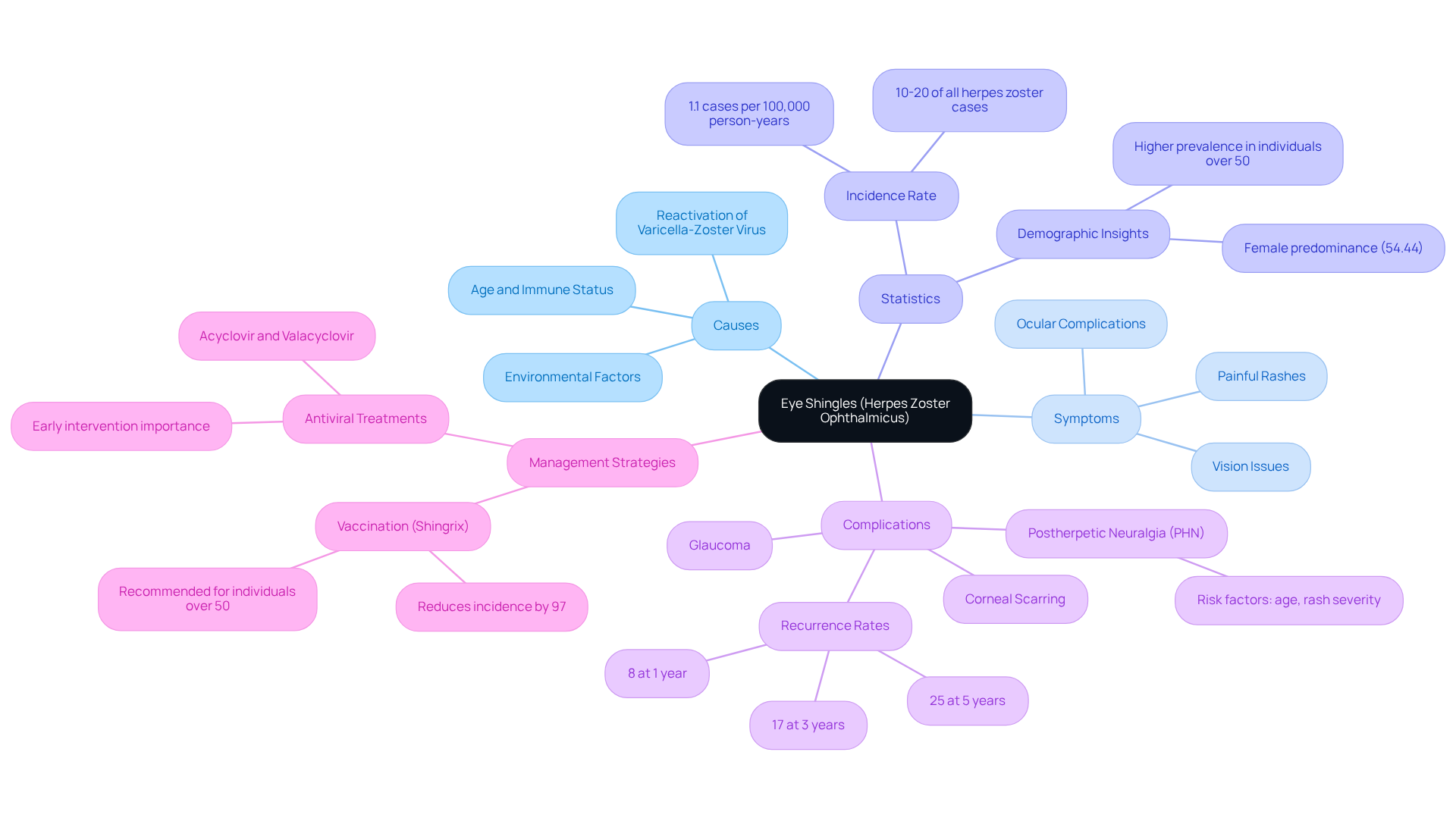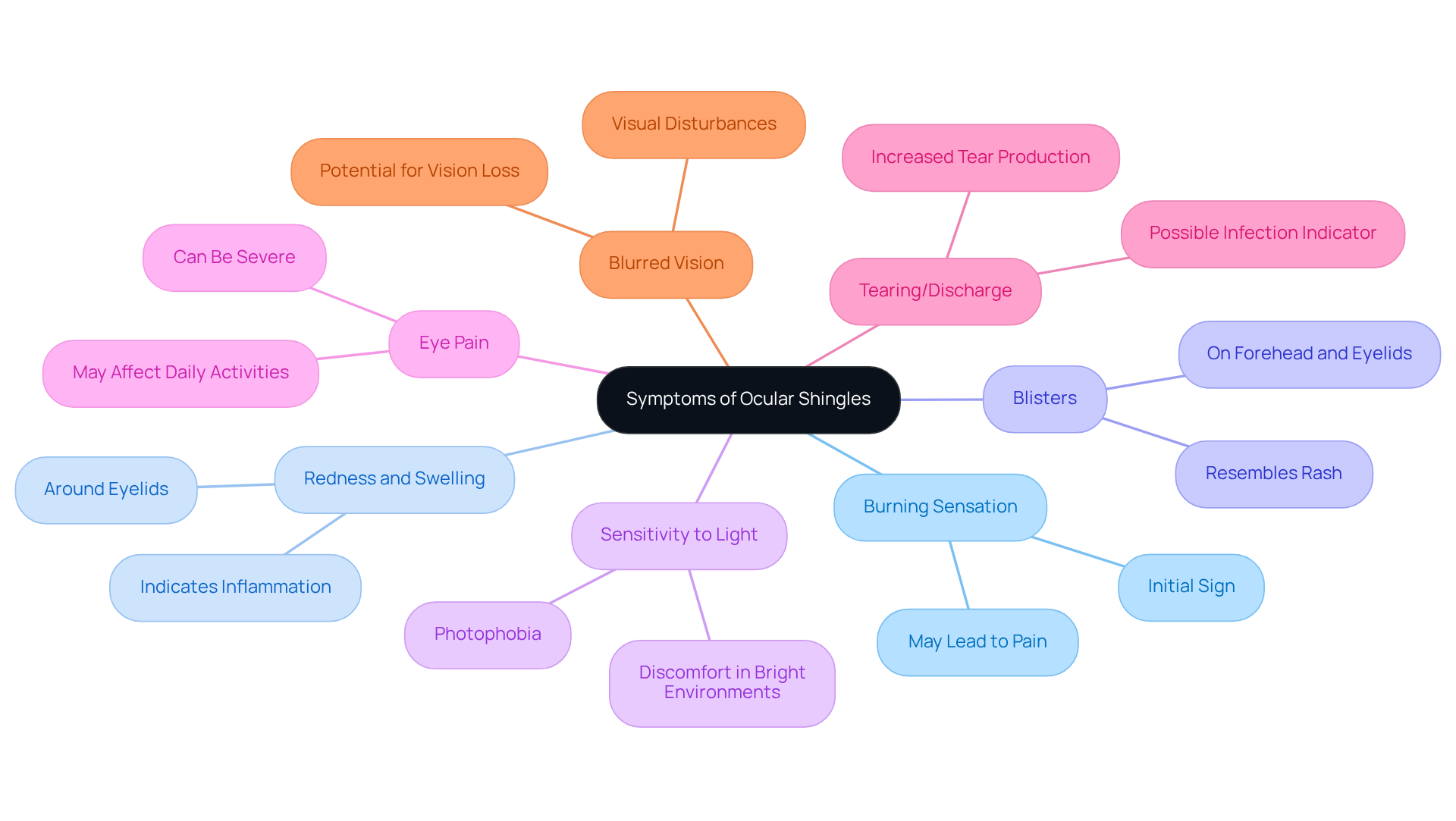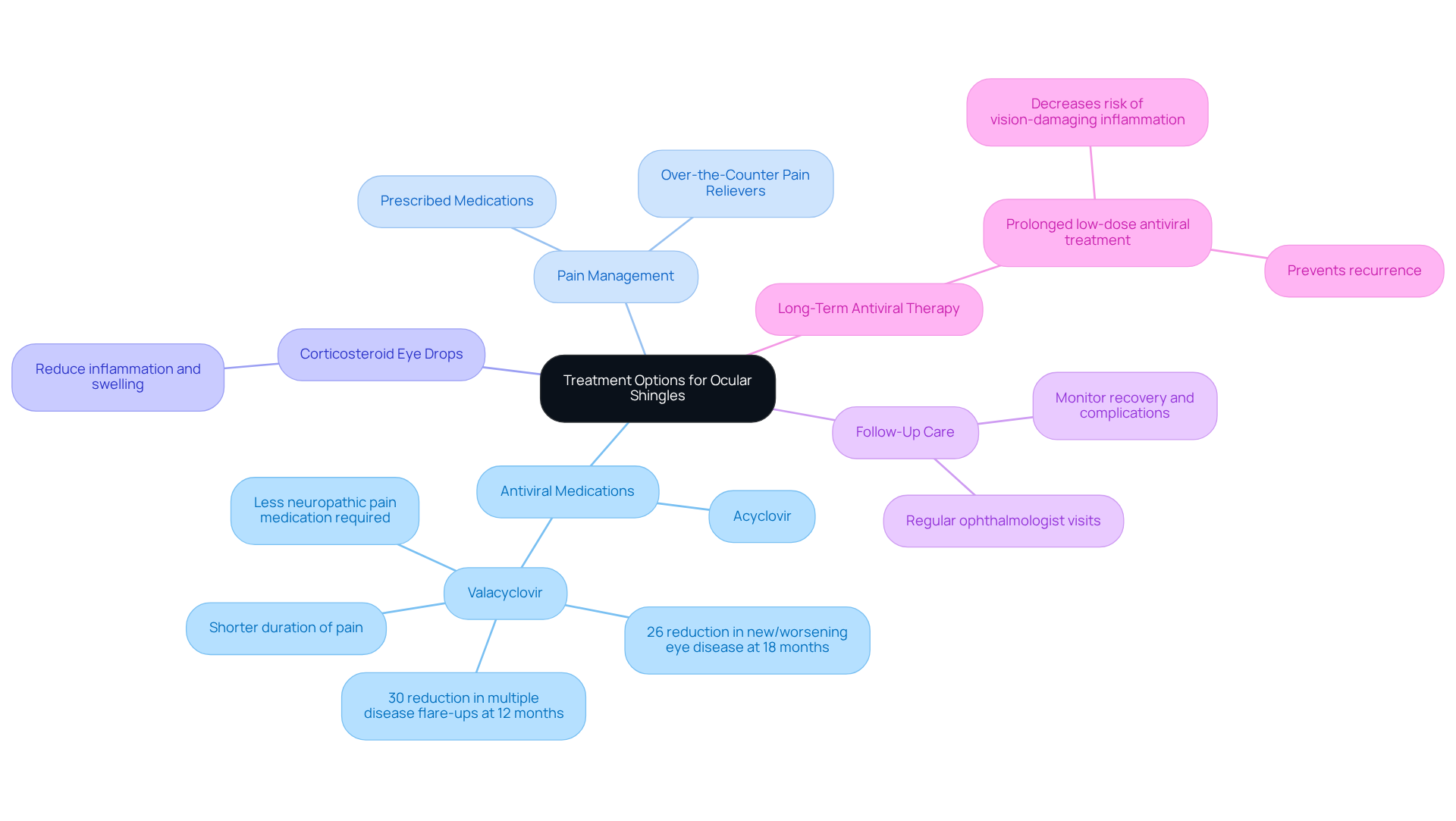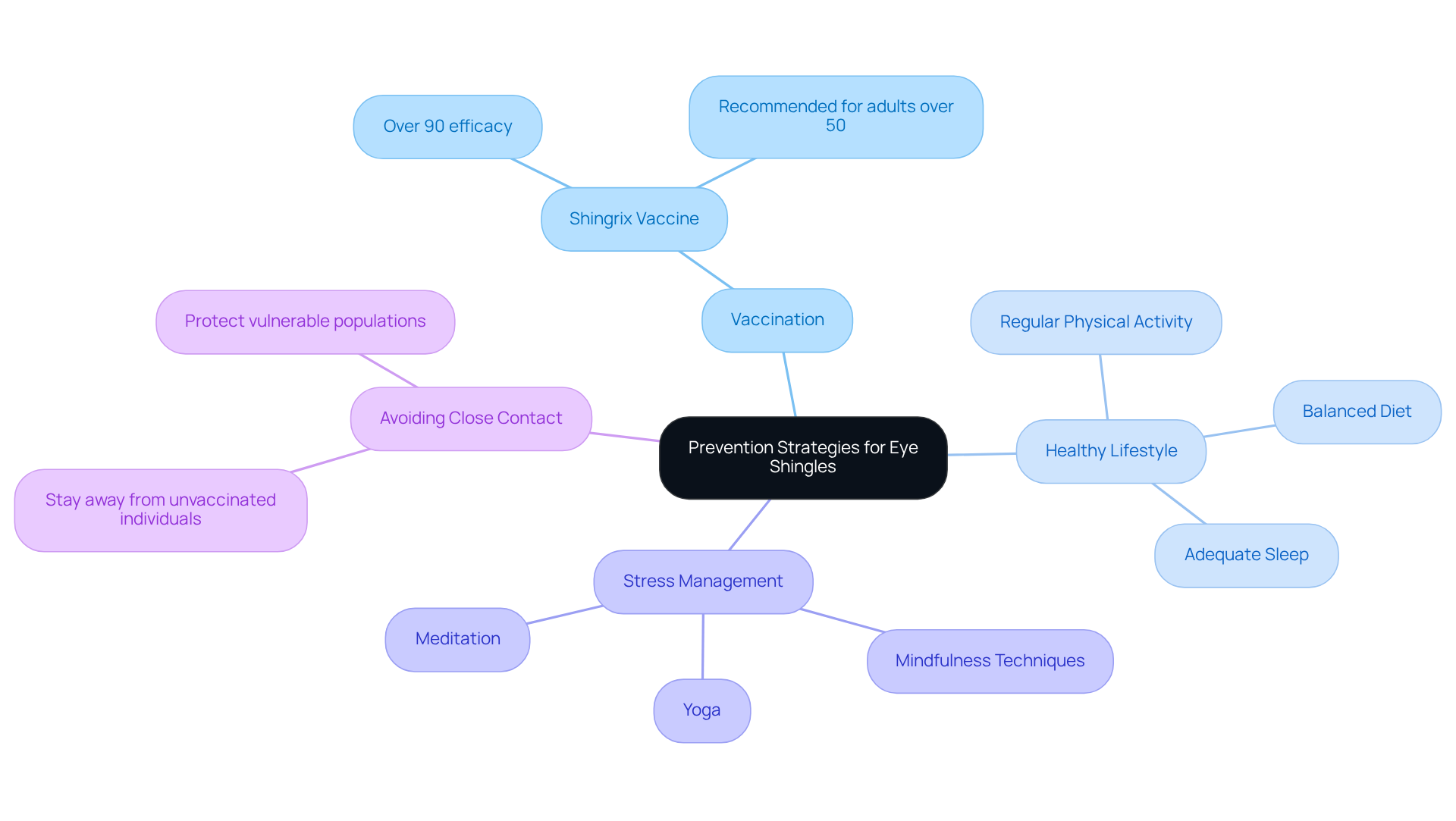Posted by: Northwest Eye in General on October 5, 2025
Overview
Eye shingles, or herpes zoster ophthalmicus, is a viral infection that can be quite distressing. It can lead to painful rashes and serious vision complications, especially in individuals over 50. We understand that learning about this condition can be concerning, but early recognition of symptoms is vital. Prompt treatment with antiviral medications can help prevent long-term issues.
It’s common to feel overwhelmed, but it’s important to know that:
- Vaccination can significantly reduce the risk of reactivation of the varicella-zoster virus.
- Maintaining a healthy lifestyle can also help in reducing this risk.
We are here to help you through this process and encourage you to take proactive steps for your health.
Introduction
Eye shingles, or herpes zoster ophthalmicus, is a health concern that can deeply affect individuals, particularly those over the age of 50. We understand that facing a viral infection, which arises from the reactivation of the varicella-zoster virus, can be daunting. This condition may lead to painful rashes and serious complications that impact vision, causing distress and worry. As the prevalence of eye shingles continues to rise, it becomes increasingly crucial to understand its symptoms, treatment options, and prevention strategies.
What steps can you take to safeguard your eye health and mitigate the risks associated with this distressing condition? Knowing more about eye shingles can help ease your concerns and empower you to take action. It’s common to feel overwhelmed, but we are here to help you through this process. Together, we can explore ways to protect your vision and well-being.
Define Eye Shingles: Understanding Herpes Zoster in the Eye
Eye shingles, also referred to as herpes zoster ophthalmicus (HZO), is a viral infection that arises from the reactivation of the varicella-zoster virus, responsible for chickenpox, within the ophthalmic nerve. We understand that this condition can be concerning, as it mainly impacts the eye and nearby regions, resulting in painful rashes and possible vision issues. Understanding HZO is essential, as it can lead to severe complications in the eyes, including eye shingles, corneal scarring, and glaucoma if left untreated. Typically, the infection manifests on one side of the face, often involving the forehead, eyelids, and sometimes the nose, indicating the involvement of the ophthalmic nerve.
Statistics reveal that HZO accounts for approximately 10-20% of all herpes zoster cases, with an estimated incidence rate of 1.1 cases per 100,000 person-years annually. It’s common to feel anxious about health issues, especially as recent studies indicate that the prevalence of eye shingles increases with age, particularly among individuals over 50 years old. This highlights the need for increased awareness and vaccination efforts in this demographic.
Real-world experiences demonstrate the possible challenges of HZO. Patients may experience recurrent keratitis and uveitis, with recurrence rates reported at 8%, 17%, and 25% at 1, 3, and 5 years, respectively. Ophthalmologists emphasize the importance of early intervention, as untreated eye shingles can lead to long-term vision impairment and chronic pain. The risk of developing postherpetic neuralgia (PHN) is also significant, with factors such as age and the severity of the initial rash influencing outcomes.
Understanding eye shingles is crucial for effective management and prevention. The condition not only affects individual health but also poses a broader public health concern due to its increasing incidence and associated healthcare costs. As the population grows older, we recognize the necessity for proactive strategies to tackle HZO and its challenges. We are here to help you through this process, ensuring you receive the care and support you need.

Identify Symptoms: Recognizing Signs of Ocular Shingles
Symptoms of eye shingles can manifest in various ways, often beginning with a burning or tingling sensation around the forehead or eyelids. You might notice redness and swelling of the eyelid and surrounding skin, along with blisters that can appear on the forehead, eyelids, or nose, resembling a rash associated with eye shingles. It’s common to experience sensitivity to light (photophobia) and eye pain, which can be related to eye shingles, as well as tearing or discharge from the eye. Blurred vision or other visual disturbances may also occur due to eye shingles.
Recognizing these symptoms early is crucial. Timely treatment can significantly reduce the risk of serious complications, including vision loss. Research indicates that about 8% of patients with herpes zoster encounter complications such as eye shingles, with 10% of those cases leading to moderate to severe vision impairment. Many patients express the distress these symptoms can cause, highlighting the importance of seeking immediate medical attention.
Eye specialists emphasize that prompt identification of eye shingles can lead to better outcomes. Initiating therapy within 72 hours of the onset of symptoms can help prevent prolonged problems. Therefore, recognizing these signs is essential for anyone who has had chickenpox, as they are at risk of developing this condition.
We understand that experiencing these symptoms can be alarming, but we are here to help you through this process. If you notice any of these signs, please reach out to a healthcare professional as soon as possible.

Explore Treatment Options: Managing Ocular Shingles Effectively
Effective treatment for eye shingles is essential for reducing issues and managing symptoms. We understand that dealing with this condition can be challenging, and we are here to support you. Key components of treatment include:
-
Antiviral Medications: Initiating antiviral therapy with medications such as acyclovir or valacyclovir within 72 hours of symptom onset is crucial. Studies indicate that valacyclovir can lead to a 26 percent reduction in the risk of new or worsening eye disease at 18 months. Additionally, participants treated with valacyclovir experienced a 30 percent reduction in multiple disease flare-ups at 12 months, underscoring the importance of early intervention.
-
Pain Management: It’s common to feel discomfort associated with the infection. Patients often benefit from over-the-counter pain relievers or prescribed medications to alleviate this discomfort. Research shows that those treated with valacyclovir experienced a shorter duration of pain and required significantly less neuropathic pain medication, highlighting its effectiveness in pain management.
-
Corticosteroid Eye Drops: These may be prescribed to reduce inflammation and swelling in the eye, which is essential for recovery and helps prevent additional issues.
-
Follow-Up Care: Regular follow-ups with an ophthalmologist are crucial for monitoring recovery and addressing any complications that may arise. This continuous care is particularly important because repeated herpes zoster flare-ups can result in chronic eye disease and vision loss.
-
Long-Term Antiviral Therapy: In certain cases, a prolonged course of antiviral medication may be recommended to prevent recurrence and manage chronic pain. Prolonged, low-dose antiviral therapy has been demonstrated to decrease the likelihood of vision-damaging inflammation and infection from herpes zoster impacting the eye.
Current guidelines highlight the significance of these treatment approaches, especially for elderly patients who are more prone to chronic pain following eye shingles. By following these suggestions, you can efficiently handle eye herpes and reduce the likelihood of long-term issues. Remember, we are here to help you through this process.

Implement Prevention Strategies: Reducing the Risk of Eye Shingles
To effectively reduce the risk of developing eye shingles, we understand that you may be looking for practical strategies. Here are some compassionate recommendations:
-
Vaccination: We highly recommend the Shingrix vaccine for adults over 50. This vaccine has shown over 90% efficacy in preventing shingles and its complications, including postherpetic neuralgia. By getting vaccinated, you are taking an important step to preserve your eye health, as shingles can lead to significant ocular issues. As noted, ‘Shingrix is over 90% effective at preventing the condition and postherpetic neuralgia in adults 50 years and older.’
-
Healthy Lifestyle: It’s common to feel overwhelmed by health advice, but adopting a balanced diet rich in vitamins and minerals, engaging in regular physical activity, and ensuring you get adequate sleep can truly bolster your immune system. A strong immune response is crucial in preventing the reactivation of the varicella-zoster virus, which leads to the outbreak of the disease. Health experts emphasize that ‘sustaining a healthy way of life can greatly reduce the chances of this condition recurring.’
-
Stress Management: We understand that stress can be a major trigger for herpes zoster outbreaks. Incorporating stress-reduction techniques such as mindfulness, yoga, or meditation can be incredibly beneficial. Health specialists affirm that managing stress effectively can significantly lower the chances of reactivation.
-
Avoiding Close Contact: During an active herpes zoster outbreak, it’s vital to avoid close contact with individuals who have not had chickenpox or the vaccine, especially pregnant women and those with weakened immune systems. This precaution helps prevent the spread of the virus and protects those who are most vulnerable.
By following these supportive strategies, you can significantly reduce your risk of eye shingles and improve your overall eye health. Remember, we are here to help you through this process.

Conclusion
Eye shingles, or herpes zoster ophthalmicus, is a significant health concern that arises from the reactivation of the varicella-zoster virus. We understand that this condition can be alarming, as it not only affects the eye but can also lead to severe complications if not recognized and treated promptly. Understanding the symptoms, treatment options, and preventative measures is essential for managing this viral infection effectively and safeguarding your vision.
Key insights into eye shingles include the importance of recognizing early symptoms such as:
- Burning sensations
- Redness
- Blisters around the eyes
It’s common to feel worried about these signs. Timely intervention with antiviral medications and appropriate pain management can greatly reduce the risk of long-term complications like vision impairment. Furthermore, vaccination and lifestyle modifications play a crucial role in prevention, particularly for individuals over 50, who are at a higher risk.
In summary, fostering awareness and understanding of eye shingles is vital for your health and the health of our community. We emphasize early recognition, effective treatment, and proactive prevention strategies, as these can significantly mitigate the impact of this condition. Taking these steps not only protects your personal well-being but also contributes to broader community health efforts in combating herpes zoster-related complications. Remember, we are here to help you through this process.
Frequently Asked Questions
What is eye shingles?
Eye shingles, also known as herpes zoster ophthalmicus (HZO), is a viral infection caused by the reactivation of the varicella-zoster virus, which is responsible for chickenpox. It primarily affects the eye and surrounding areas, leading to painful rashes and potential vision problems.
What are the potential complications of eye shingles?
If left untreated, eye shingles can lead to severe complications such as corneal scarring and glaucoma, as well as chronic pain and long-term vision impairment.
How common is herpes zoster ophthalmicus?
HZO accounts for approximately 10-20% of all herpes zoster cases, with an estimated incidence rate of 1.1 cases per 100,000 person-years annually.
Who is most at risk for developing eye shingles?
The prevalence of eye shingles increases with age, particularly among individuals over 50 years old, making this demographic more susceptible to the condition.
What are the recurrence rates for eye shingles?
Patients may experience recurrent conditions such as keratitis and uveitis, with recurrence rates reported at 8%, 17%, and 25% at 1, 3, and 5 years, respectively.
Why is early intervention important for eye shingles?
Early intervention is crucial because untreated eye shingles can result in long-term vision impairment and chronic pain, as well as a significant risk of developing postherpetic neuralgia (PHN).
What factors influence the outcomes of eye shingles?
Factors such as age and the severity of the initial rash can influence the outcomes of eye shingles, including the risk of developing postherpetic neuralgia.
What is the public health concern related to eye shingles?
The increasing incidence of eye shingles and its associated healthcare costs pose a broader public health concern, highlighting the necessity for proactive strategies to manage and prevent HZO.






